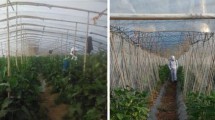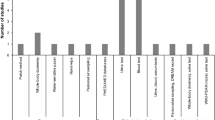Abstract
Several circumstances have revealed a need for better appraisal of the hazard incurred by workers who reenter cotton fields recently treated with pesticides: (1) the increased use of parathions and other organophosphate insecticides on cotton as substitutes for DDT, (2) the rapid expansion of cotton pest-management programs involving large numbers of cotton checkers, and (3) a lack of human exposure information for establishing reentry intervals. A “reentry interval” is the waiting period required to protect field workers from possible poisoning when they enter pesticide-treated fields. Reentry information on treated fields is needed essentially for workers who are intimately associated with the foliage of maturing cotton for extended periods, e.g., cotton insect field checkers (cotton scouts), hoe crews, and scientists. Irrigators and tractor drivers are the only other personnel entering fields and they do not normally contact cotton foliage. Cotton scouts, by reason of their direct contact with cotton foliage, in field after field, for up to 10 hr of intermittent exposure/day and approaching 40 hr/week, become the principal concern in establishing safe reentry intervals for cotton.
Contribution to Regional Project W-45, “Residues of Selected Pesticides and Related Chemicals in the Agricultural Environment—Their Nature, Distribution, Persistence, and Toxicological Implications.” Ag. Expt. Sta. #2286.
Access this chapter
Tax calculation will be finalised at checkout
Purchases are for personal use only
Preview
Unable to display preview. Download preview PDF.
Similar content being viewed by others
References
Arterberry, J. D., W. F. Durham, J. W. Elliott, and H. R. Wolfe: Exposure to parathion: Measurement by blood cholinesterase level and urinary p-nitrophenol excretion. Arch. Environ. Health 3, 476 (1961).
Bailey, J. B.: Factors that must be considered in conducting “Farm Workers Reentry Monitoring Studies.” Unpublished report, Dept. of Entomol., Univ. of Calif., Berkeley, Part I, 4 pp. (1972).
Barnes, G., H. Roberts, H. R. Hurst, D. Ibsen, and M. Appleberry: A cholinesterase study on persons with phosphate insecticide exposure—1966. Unpublished report, Agr. Ext. Serv. Univ. of Ark., Fayetteville, 4 pp. (1967).
Cranmer, M.: Determination of p-nitrophenol in human urine. Bull. Environ. Contain. Toxicol. 5, 329 (1970).
Davies, J. E., J. H. Davis, D. E. Frazier, J. B. Mann, and J. O. Welke: Urinary p-nitrophenol concentrations in acute and chronic parathion exposures. Adv. Chem. Series 60, 67 (1966).
Elliott, J. W., K. C. Walker, A. E. Penick, and W. F. Durham: A sensitive procedure for urinary p-nitrophenol determination as a measure of exposure to parathion. J. Agr. Food Chem. 8, 111 (1960).
Gage, J. C.: Blood cholinesterase values in early diagnosis of excessive exposure to phosphorus insecticides. Brit. Med. J. 1, 1370 (1955).
Hartwell, W. F., and G. R. Hayes, JR.: Respiratory exposure to organic phosphorus insecticides. AMA Arch. Environ. Health 11, 564 (1965).
Hayes, G. R., JR., A. J. Funckes and W. V. Hartwell: Dermal exposure of human volunteers to parathion. AMA Arch. Environ. Health 8, 829 (1964).
Michel, H. O.: An electrometric method for the determination of red blood cell and plasma cholinesterase activity. J. Lab. Clin. Med. 34, 1564 (1949).
Quinby, G. E., K. C. Walker, and W. F. Durham: Public health hazards involved in the use of organic phosphorus insecticides in cotton culture in the Delta area of Mississippi. J. Econ. Entomol. 51, 831 (1958).
Rider, J. A., H. C. Moeller, E. J. Puletti, and J. I. Swader: Toxicity of parathion, Systox, octamethyl pyrophosphoramide and methyl parathion in man. Toxicol. Applied Pharmacol. 14, 603 (1969).
Rider, J. A., J. L. Swader, and E. J. Puletti: Anticholinesterase toxicity studies with methyl parathion, Guthion and Phosdrin in human subjects. Abstract 1382, Fed. Proc. 30, 442 (1971).
Roan, C. C., D. P. Morgan, N. Cook, and E. H. Paschal: Blood cholinesterases, serum parathion concentrations and urine p-nitrophenol concentrations in exposed individuals. Bull. Environ. Contam. Toxicol. 4, 362 (1969).
Shafik, M. T., D. E. Bradway, H. F. Enos, and A. R. Yobs: Human exposure to organophosphate pesticides. A modified procedure for the GLC analysis of alkyl phosphate metabolites in urine. J. Agr. Food Chem. 21, 625 (1973 a).
Shafik, M. T., H. C. Sullivan, and H. R. Enos: Multiresidue procedure to halo- and nitrophenols. Measurement of exposure to biodegradable pesticides yielding these compounds as metabolites. J. Agr. Food Chem. 21, 295 (1973 b).
Ware, G. W., D. P. Morgan, B. J. Estesen, W. P. Cahill, and D. M. Whitacre: Establishment of reentry intervals for organophosphate-treated cotton fields based on human data: I. Ethyl- and methyl parathion. Arch. Environ. Contam. Toxicol. 1, 48 (1973).
Ware, G. W., D. P. Morgan, B. J. Estesen, W. P. Cahill: Establishment of reentry intervals for organophosphate-treated cotton fields based on human data: II. Azodrin, ethyl and methyl parathion. Arch. Environ. Contam. Toxicol. 2, 117 (1974 a).
Ware, G. W., D. P. Morgan, B. J. Estesen, W. P. Cahill: Establishment of reentry intervals for organophosphate-treated cotton fields based on human data: III. 12-72 hours post-treatment exposure to Azodrin, ethyl and methyl parathion. Submitted Arch. Environ. Contam. Toxicol. (1974b).
Author information
Authors and Affiliations
Editor information
Editors and Affiliations
Rights and permissions
Copyright information
© 1976 Springer-Verlag New York Inc.
About this paper
Cite this paper
Ware, G.W., Morgan, D.P. (1976). Worker reentry safety. IX. Techniques of determining safe reentry intervals for organophosphate-treated cotton fields. In: Gunther, F.A., Hylin, J.W., Westlake, W.E. (eds) Residue Reviews. Reviews of Environmental Contamination and Toxicology, vol 62. Springer, New York, NY. https://doi.org/10.1007/978-1-4613-9404-4_9
Download citation
DOI: https://doi.org/10.1007/978-1-4613-9404-4_9
Publisher Name: Springer, New York, NY
Print ISBN: 978-1-4613-9406-8
Online ISBN: 978-1-4613-9404-4
eBook Packages: Springer Book Archive




